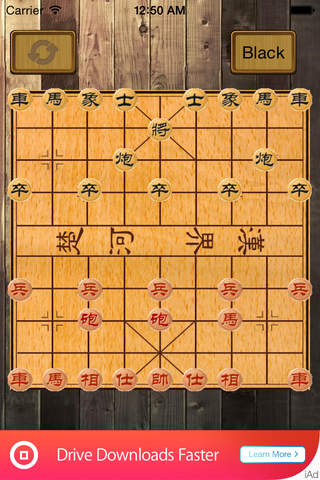
Chess.One app for iPhone and iPad
Developer: Ngoc Duy Le
First release : 07 Apr 2015
App size: 4.53 Mb
1.
Set up the Chinese chess playing board. The board itself has 64 squares, as international chess board does. However, the Chinese chess board has a river in the middle that divides the board between opposing players. No plays can be made in the river.
Chinese chess pieces are placed on line intersections, which are called points, instead of in the actual board squares. The board is made up of 9 by 10 points.
On each side of the playing board, there is an Imperial Palace where the general and guard pieces are not allowed to leave.
2.
Determine which playing pieces to start with. Each player needs 16 pieces: 1 general (king), 2 guards, 2 elephants (bishops), 2 chariots (rooks), 2 horses (knights), 2 cannons and 5 soldiers (pawns). Each piece is a flat disk with either red or black markings. Choose to be either red or black.
3.
Set your pieces on the board. On the row nearest you, place on points from left to right: the chariot, horse, elephant, guard, king, guard, elephant, knight and chariot (rook). On the third row, place all cannons. On the fourth row, place all soldier pieces.
4.
Learn the rules that apply to each pieces movement on the board.
The general can move 1 space back or forward, right or left but cannot make a move diagonally. This piece is also not allowed to leave the Imperial Palace area. The general piece may capture any enemy piece which strays into the Imperial Palace area unless that piece is protected by another piece. Also, very importantly, the generals on the opposite side of the board cannot meet (be on the same row without any piece in between) whoever caused the meeting loses. However this means the general can force the opposite general into checkmate since (if there is no piece between) the general can make sure the opposite general cant access 1 row of the Imperial Palace.
A chariot or rook piece can move any number of spaces in a straight line horizontally or vertically through the rows of the board.
The horse piece is equivalent to the knight in international chess rules, in that it can move 1 point any direction and 1 point diagonally (aka 2 points in one direction and 1 point perpendicular to it). However, the horse cannot jump another piece (e.g. If there is a piece in front of the horse blocking its path of 2 points forward).
Cannon move rules are the same as the chariot/rook with one difference. In order to capture, the cannon has to jump over only 1 piece but it can be of either color.
Guards can move only 1 point diagonally in either direction but, they cannot leave the Imperial Palace.
The elephant can move 2 points diagonally, as a bishop can in international chess. However an elephant cannot cross the river designated on the board. If there is a piece on the point which the elephant has to jump over in order to get to the second point then the elephant cant get to the second point.
Soldiers can only move and capture 1 point forward (not diagonally) until they cross the river. Once they cross the river, soldiers can move 1 point to the left or right or forwards but not backwards.
5.
Practice Chinese chess rules and learn what each move is called. The player with the red pieces makes the first move, and then players alternate turns.
To "capture" is to take over the point that the opposing team occupies. Its the same strategic move thats used in international chess.
You put your opponents general in "check" if your next move will capture the piece. Your opponents next move has to be to protect the general from capture
6.
Win the game by putting your opponents general in checkmate or by forcing a stalemate.
A "checkmate" occurs when the general cannot escape capture. You can also win if you force your opponent into a "stalemate," in which your opponent cannot make a legal move to protect his general.
The game is a draw when neither player can force a stalemate or checkmate.

